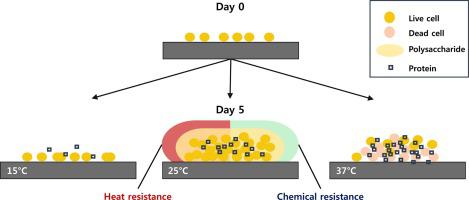Food Research International ( IF 7.0 ) Pub Date : 2020-06-12 , DOI: 10.1016/j.foodres.2020.109432 Woo-Ju Kim , Soo-Hwan Kim , Dong-Hyun Kang

|
The objective of this study was to investigate the effect of temperature and maturation period on the resistance of Staphylococcus aureus biofilms to thermal and non-thermal treatments. First, biofilm development was compared at three different temperatures (15, 25, and 37°C) for 5 days. The cell population at 15 and 25°C remained relatively consistent approximately at 6.3 log CFU/cm2, whereas 37°C resulted in the highest cell population on day 1 (7.6 log CFU/cm2) followed by a continual decline. Then, biofilm resistance to steam and sodium hypochlorite (NaOCl) treatments was evaluated. Obtained results highlighted that biofilms had different resistance to both treatments depending on development conditions. Specifically, steam treatment of 10 s eliminated 4.1 log CFU/cm2 of the biofilm formed at 25°C for 5 days. The same treatment inactivated over 5 log population of biofilms developed in other temperature and maturation period conditions. Treatment with NaOCl reduced approximately 1 log CFU/cm2 of biofilm cells developed at 25°C for 5 days. However, inactivation was found to be over 2 log CFU/cm2 under other development conditions. An extracellular polymeric substances (EPS) quantification using 96-well plates and stainless steel coupons was conducted. In the 96-well plate experiment, it was found that the highest amount of polysaccharide was secreted at 25°C (p < 0.05), while total biomass and protein contents were greatest at 37°C (p < 0.05). No significant difference in EPS content was observed for stainless steel, but the results displayed a similar trend to the 96-well plate. In particular, biofilms developed at 25°C tended to secret the highest amount of polysaccharide, which aligned with the current literature. This finding indicated that polysaccharide was the main contribution to the enhanced resistance of S. aureus biofilms. Overall, it was shown that biofilms formed at 25°C for 5 days exhibited the greatest resistance to thermal and nonthermal treatments due to the elevated exopolysaccharide secretion. This study demonstrates that temperature and maturation period significantly affect the resistance of S. aureus biofilms to thermal and non-thermal treatments.
中文翻译:

热处理和非热处理对在不同温度和成熟期形成的金黄色葡萄球菌生物膜的影响
这项研究的目的是研究温度和成熟期对金黄色葡萄球菌生物膜对热处理和非热处理的抗性的影响。首先,在三个不同的温度(15、25和37°C)下比较了5天的生物膜发育。15和25°C时的细胞群体保持相对一致,大约为6.3 log CFU / cm 2,而37°C导致第1天的细胞群体最高(7.6 log CFU / cm 2),然后持续下降。然后,评估了生物膜对蒸汽和次氯酸钠(NaOCl)处理的抵抗力。获得的结果表明,生物膜对两种处理的抵抗力均取决于发育条件。具体地,10秒的蒸汽处理消除了在25℃下形成的生物膜的4.1log CFU / cm 2达5天。在其他温度和成熟期条件下,相同处理会使超过5 log的生物膜种群失活。用NaOCl处理降低了在25℃下发展5天的生物膜细胞的大约1log CFU / cm 2。但是,发现失活超过2 log CFU / cm 2在其他发展条件下。使用96孔板和不锈钢试样进行了细胞外聚合物(EPS)定量。在96孔板实验中,发现在25°C时分泌的多糖量最高(p <0.05),而在37°C时总生物量和蛋白质含量最大(p <0.05)。对于不锈钢,EPS含量没有显着差异,但结果显示出与96孔板相似的趋势。特别是,在25°C下显影的生物膜往往会分泌最多量的多糖,这与当前文献一致。这一发现表明,多糖是提高金黄色葡萄球菌抗性的主要作用。生物膜。总的来说,由于增加的胞外多糖分泌,表明在25°C下形成5天的生物膜对热处理和非热处理的抵抗力最大。这项研究表明温度和成熟期显着影响金黄色葡萄球菌生物膜对热处理和非热处理的抵抗力。











































 京公网安备 11010802027423号
京公网安备 11010802027423号